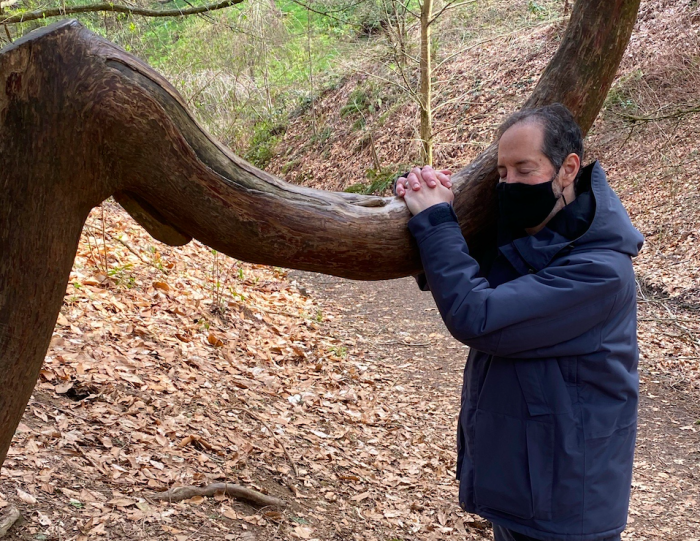The first time I experienced pranayama, the practice of conscious breathing, I thought it required too much strenuous self-control for me—a somewhat indulgent Westerner—to commit to.
The class was doing “breath of fire,” which involved a series of rapid exhalations through the nose punctuated by brief inhalations. This exercise also called for a couple of body “locks,” one of which involved contracting my pelvic floor, an action that felt like a strange tightening of the muscles around my anus. I decided that, at least for a while, I wouldn’t seek out further opportunities to practice pranayama.
When I visited India a few years later, I came across a popular book on yoga that had been translated into English (Yog: Its Philosophy & Practice by Swami Ramdev, 2008). The section on pranayama reinforced the sense I originally had that pranayama consisted of a muscular set of breathing exercises, requiring forceful control of the breath.
For example, regarding a pranayama practice called Abhyantara vritti, the author spoke about sitting in meditation while exhaling and inhaling as much as possible, with the upper chest bulging out and the lower abdomen contracted in on the inhalation, and with the pelvic floor lock sort of sealing the deal.
For another pranayama, the author told the reader to bring the prana, or rising energy, from above and Apana, or descending energy, from below and “let them fight in the nasal area.”
I gained the impression from this book that pranayama was not for the faint of heart. While I knew there were documented benefits of this assertive approach to breathing (and I was sure that for seasoned practitioners it made sense), for me, it seemed intimidating and unappealing.
Since my initial, jolting exposure to pranayama, I’ve experienced pranayama less as a way of controlling the breath and more as a way of freeing it. Happily, I recently completed a week-long immersion program on the breath—part of a yoga sanctuary I previously wrote about, and this theme of freeing the breath was at the center of the practice.
I’d like to share three ways to free the breath that I’ve found refreshing and rejuvenating.
Escort the Breath Rather than Directing It
I like to guide my breath to areas of tension in my body because the breath can help soften and release the tension. But I have to watch in myself an old tendency to shoot the breath over to tense places as if those places were targets and the breath needed to be launched and directed to hit them. Not surprisingly, this breath-as-a-missile approach doesn’t dissolve tension; it may even aggravate it.
What does work for me is to think of myself escorting the breath as if my job is to open doors for it and encourage its movement to a desired destination. No pushing required.
For example, I tend to tighten my jaw when I’m feeling pressure. This might happen when, for example, I’m in my car and facing a lot of traffic, at my computer and working on a knotty technical issue, or on my yoga mat and straining in a pose.
If I bring attention to my clenching jaw and then encourage my breath to follow my attention, my jaw muscles relax. If I then let my breath swirl around a bit inside my cheeks and loosen my tongue, my jaw and mouth feel more mellow. Further, if I let an inhalation tickle the inside of my nostrils, my face, as a whole, softens.
Escorting the breath along the line of my attention helps me to feel more at ease than trying to control my breath.
Let the Breath Brighten the Pelvic Floor and not Just Tighten it
Earlier I referred to a pelvic lock, called Mula bandha in yoga circles, that required a tightening of the muscles at the base of the pelvis. In this lock, the inhalation initiates the contraction, which can be beneficial for skilled practitioners, but which also can feel like a curious, not-so-pleasant squeezing of the perineum—the band of tissue stretching from the pubis to the tailbone, front to back, and between the sit bones, side to side.
I’m not arguing against Mula bandha because it certainly has its place in yoga practice. But I find that when it’s overemphasized, it can buttress the conclusion that breathwork in yoga is more about manipulating the breath than following its natural rhythm.
Regarding the pelvic floor, “natural rhythm” involves letting the diaphragm, the main breathing muscle, travel smoothly and fully in its groove. When the diaphragm moves down its central tendon to bring about an inhalation, it nudges the abdominal cavity—home to organs like the stomach and liver, downward and outward. This causes the belly to swell slightly and the pelvic floor to broaden.
Brightening the pelvis is my way of experiencing this natural flow of inhalation into the pelvic floor. The brightening inhalation feels like my pelvis comes alive and almost blooms.
To be sure, an exhalation necessarily follows an inhalation, and the brightness dims a bit on the exhale while the circle of the pelvis subtly narrows. But at no time in this inhale-exhale cycle is breath restriction necessary.
Both in yoga and in life, I like to cultivate more brightness than tightness. Neither highly controlled breathing nor highly taught living is my default state, or the state I aspire to nurture.
Let Metaphors Free the Breath and Open Possibilities
I’ve noticed when I’m breathing freely and easily—and especially when I’m doing so while walking on the forested trails in my neighborhood—metaphors come to me that deepen and extend my experience of the breath. Even the words above about “escorting” the breath and “brightening” the pelvic floor are metaphors, however simple, that help me to paint a richer picture of my breath experience and its benefits than I would have come to without the metaphors.
A nourishing metaphoric image that arose for me last month is what I call my “eye, shore, and rain” cycle. What prompted this metaphor was an awareness I experienced on a walk where my eyes were narrowly focused and my eye muscles were tight—in a manner parallel to the tightening of my jaw that I mentioned earlier.
I found myself escorting my breath to my eyes to soften my gaze and ease the muscle tension. And then, a new metaphor came along. This was the image of my breath gliding my eyes back toward the “shore” of my eye socket, a shore that served as a cozy mooring. Further, my inhalation traveled upward to the back of my skull and then, as it rounded the crown of my head, turned into an exhalation. The exhalation took an uncommon form—it appeared as a gentle rain drizzling down the sides of my cheeks and landing on the same shore that cushioned my eyes.
This eye-shore-rain cycle was a way to experience myself in terms of the natural elements and the soothing mystery of Earth/shore and water/rain. I could benefit from the steadiness and the flow that these images represented. I’ve since entered this metaphoric scene many times as part of yoga, walking, and day-to-day living. It helps me to feel anchored in my body and breath, yet at the same time, joined to a larger natural world of calmness and beauty.
Freeing the breath can be more pleasing and enriching than controlling it. A freely flowing breath can bring balance and ease. It can bring a sense of harmony with the body’s natural energy currents. And, with the help of metaphors, it can be expansive and uplifting in new and imaginative ways.

 Share on bsky
Share on bsky





Read 9 comments and reply